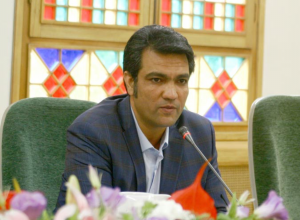 Dr Mirza Mohammad-Hasani
Dr Mirza Mohammad-Hasani
دکتر میرزا محمدحسنی
Assistant Professor of Ancient Iran
استادیار تاریخ ایران باستان
Email: mohamadhassani68@yahoo.com
Educations:
– Ph.D. dessert Title: Rome et les Sassanides: Rencontres et influences reciproques (Paris, Sorbonne IV: 2008)
– M.A. dessert Title: Antiquities and Historical Buildings of Darab (Tehran, Azad Tehran Markazi University, 2004)
Publications:
Books:
- Tarikhah Aramgah Dahya Kalbi in Darabjard, Islamic Relics Complex, Qom, 1393 (94 pages).
- Naqsh Barjesathai Noyavateh Sasani (1950-2004 AD), Tehran, Insharat Qaqnus, 1393 (207 pages)
- Majed Sangi va Asyab Sangi Darab (Historical Berrsi) – Insharat Tahuri, 1396. (200 pages)
- Joghafiyae Tarikhi Darab. 1396. Avasht: Tehran.
- Multiple Identification Alternatives for Two Sassanid Equestrians on Fīrūzābād I Relief: A Heraldic Approach, Tarikh Negar, Tehran.
Articles (for more details about every article check out the Academia profile):
- A Newly-Discovered Middle Persian Clay Sealing from Khorrambid, Fars
- The Seals and Gemstones of Sasanian Kings: A Study of the Identity of the Kings and the Motifs on These Works.
- Study of the Year Counting and Duration of Sulayman Khan’s rule; Ilkhan of Puppet of Chopanian Governors, Based on Numismatic Evidence and Historical Documents.
- The king of the world and world religion, the Interaction pattern of Shapur I and Mani
- The Role of Peasants in the Security and Welfare of the Citizens in the Early Islamic Centuries
- (The Vanished Relief of Sassanian King in Naghsh-e Rustam V: An Appraisal
- The nature of spiritual journeys in Zoroastrianism (based on Kartir and Arda Viraf trips)
- The Role of Beverages in the Wage Payment System of Achaemenid Iran
- Clercial and Legal Professions in the Achaemenid
- Final Report of the Newly Discovered Pahlavi Inscription in Darvā Village-Zarindasht (Dārāb)
- Discovery of a New Pahlavi Inscription in Darab of Fars
- Analysis of hunting motifs by Elamite seals from 3000 to 700 BC
- The status of the ancestry of Iranian women of the Sassanid court based on sources Illustrated and written history
- The social position of women in the Sassanid era (based on seals and the effect of seals)
- Mythological-religious motifs of seals and cylinder seals in ancient Elam
- Non-Zoroastrian women in the Sasanian court and their impact on policies related to religious minorities in Iran
- The statue of Shapur I in the city of Bishapur (Kazron, Fars)
- Factors affecting the overthrow of the statue of Shapur I in Shapur Cave
- Superstition in Manichaeism
- World kingdom and world religion, model of interaction between Shapur I and Mani
- Conquest of the furnaces of Fars state from the arrival of Muslims to the end of the Rashidin caliphate period
- Examining the oldest historical report of the existence of two stone coffins on the roof of Koresh Bozor Mausoleum in Pasargad
- Five new stone inscriptions from Shabankargan (8th century AH) around Darab stone mill
- Introduction of the enumerator seal and the dervish defender seal of the Qomesh state in the Sassanid era
- Revision and reflection on the effaced relief of the Sassanid king in Rostam 5
- The continuation of the presence and power of Al-Buyeh in Fars, after the official extinction (based on a tombstone from the 7th century Hijra discovered in Forg Darab)
- The role of the unread inscriptions of the Darab stone mosque in identifying the building’s function and construction date
- Birjand Kaljangal party stone painting
- Investigating the identity of the unknown emperor of Rome in the second war of Shapur I
